Below are some pictures of the front brake system in a 2000 ford crown
victoria
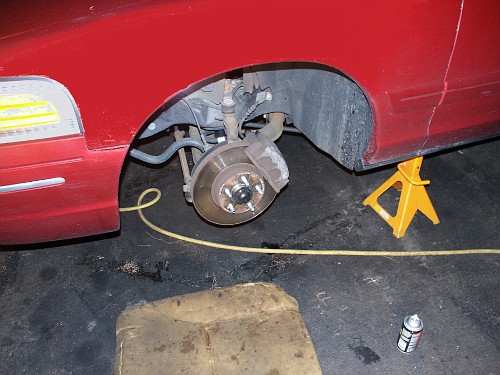
The front caliper pistons being compressed using a large eight inch
c-clamp
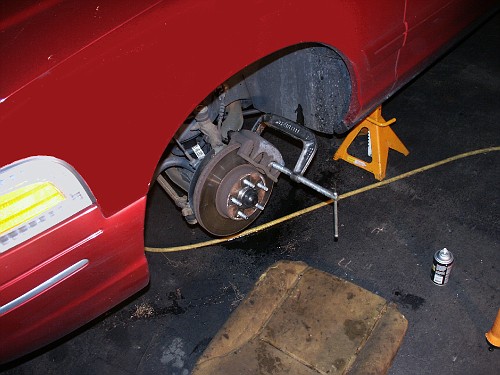
To prevent debris from the calipers from being pushed back into the
master cylinder and antilock brake valve block, the bleeder valve can
be opened some. This will also prevent the master cylinder reservoir
from having fluid flow out over the top.
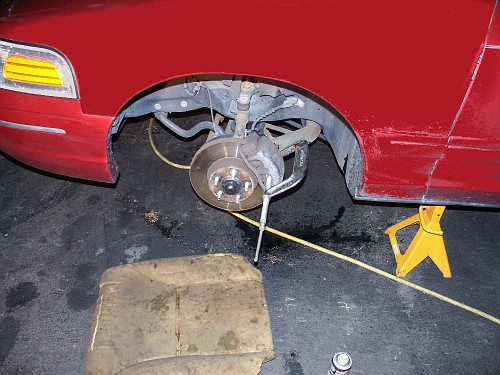
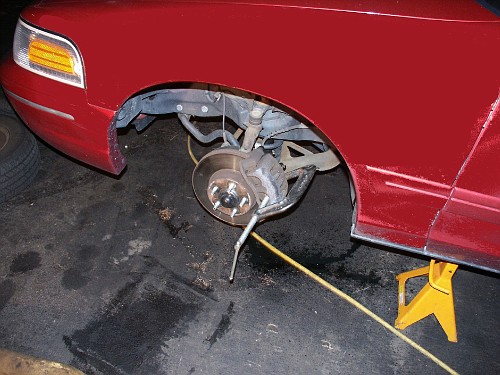
Now that the caliper pistons have been retracted, the caliper can be
removed from it's bracket
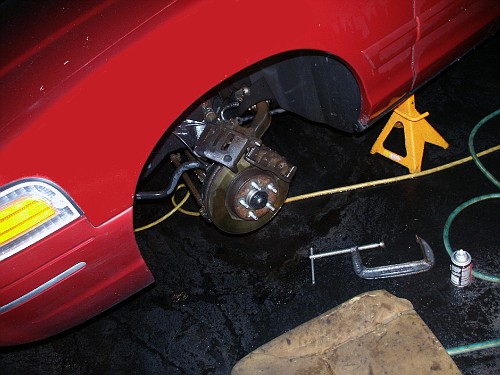
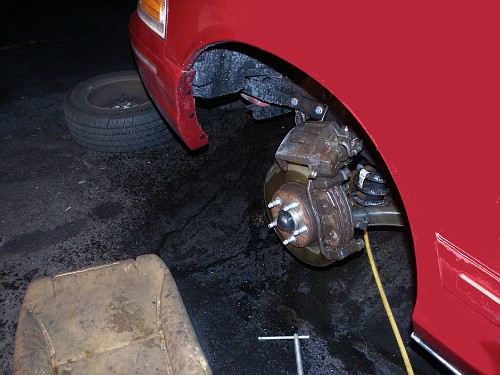
Here's a closeup of the old pads. The pads still have some useable life
left in them, but are going to be replaced anyways.
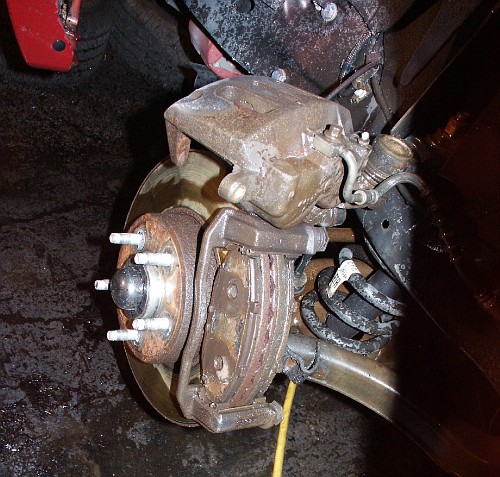
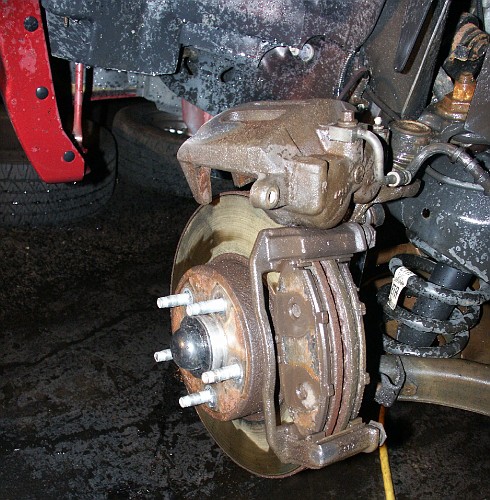

During assembly at ford's manufacturing plant, the rotors are held onto
the wheel hubs using a couple lock washers or rivets. These parts are
not needed once the car has rolled off the ford dealer's showroom
floor. And if your car has ever had the rotors removed for service
before, you won't find any rivets or lock washers here.
Here is a 2000 crownvic with the rotor lock washers still installed
indicating that the rotor has never been seperated from the hub
before.
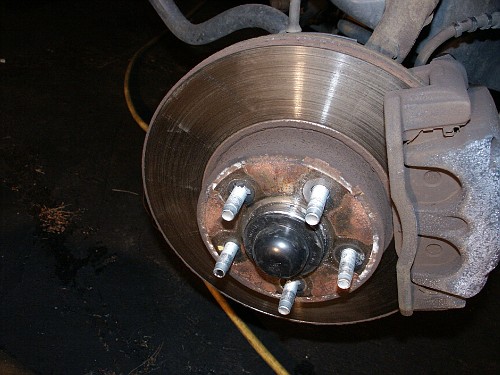
And here is a 1999 crownvic with the rotor->wheel hub rivets still
installed indicating that the rotor has never been seperated from the
hub before.
picture courtesy of vonirkinshtine on
www.crownvic.net
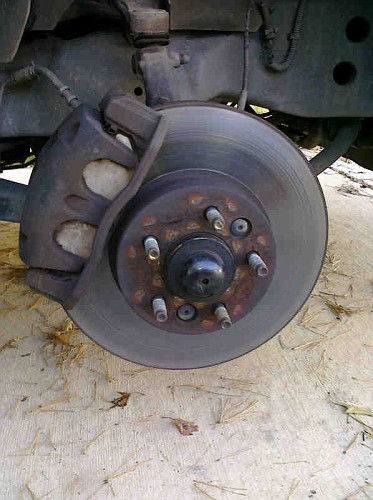
After drilling out the rivets and installing a new brake rotor.
picture courtesy of vonirkinshtine on
www.crownvic.net
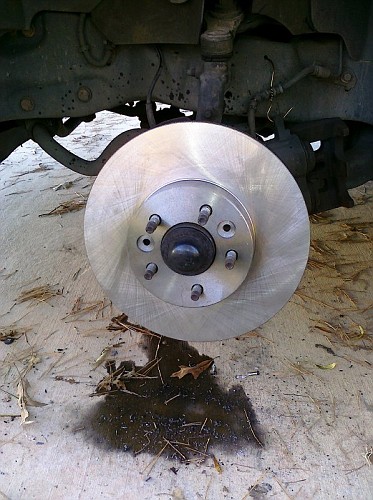
Here's the dual piston caliper that you'll find in the 1998-2002
crownvics

Here are the new performance friction brake
pads to install


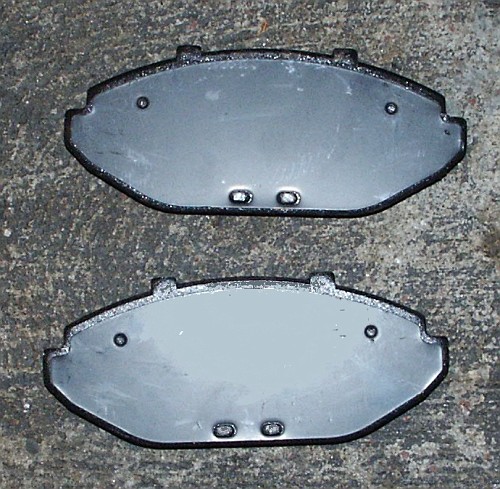
The passenger's side of the car is essentially a mirror image of the
driver's side

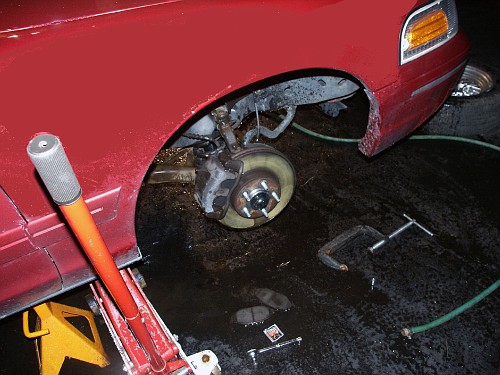
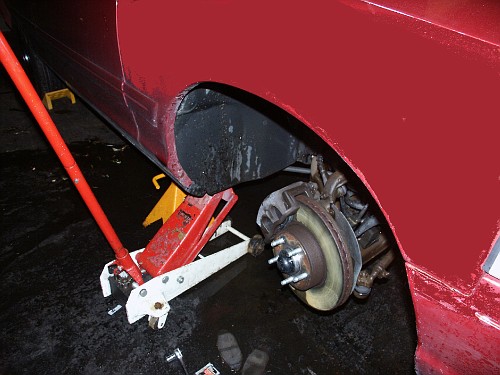
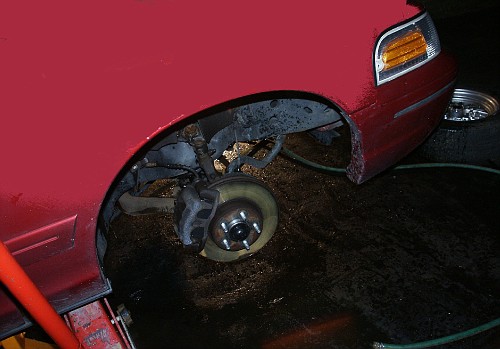
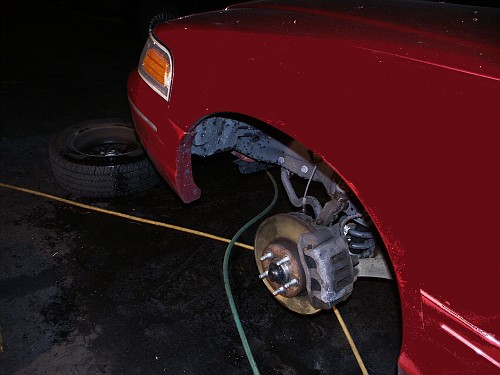
A closeup of the brake system on the passenger's side front of a 1998
crown victoria

Make sure that the anti-rattle clip doesn't fall out of the caliper
when you remove the pads.
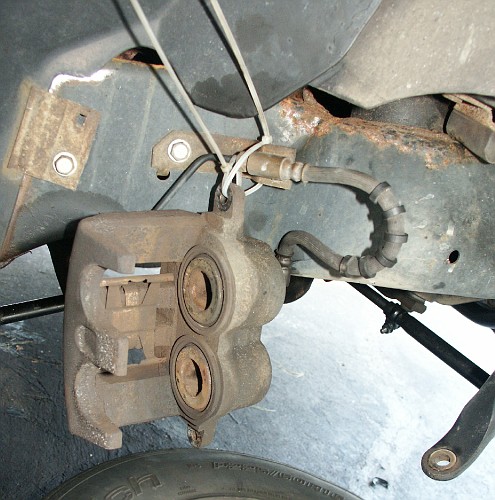
Here are the rotor and pads from a 1998 crown vic

The oem rotors for this car were manufactured are stamped Varga.
Varga is currently a brazil division of the automotive supplier TRW.
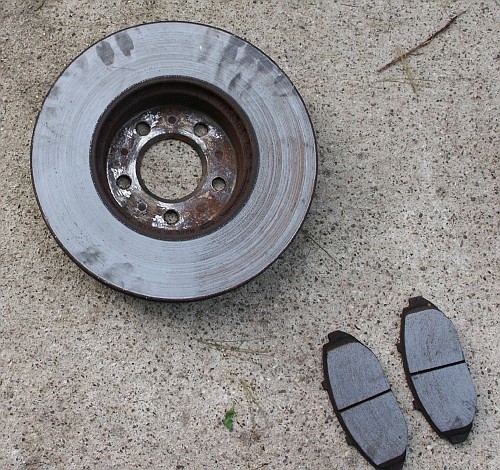
A closeup of the F8VC-1125 Ford casting information

The 1992+ crownvics have sealed front wheel bearings and the rotor hat
sits on top of the wheel bearing hub. So to have a "true" rotor that
doesn't wobble when brake pads are clamped against it, not only must
rotor runout be within acceptable limits but the wheel bearing hub
surface must also be clean and not have excessive runout either.
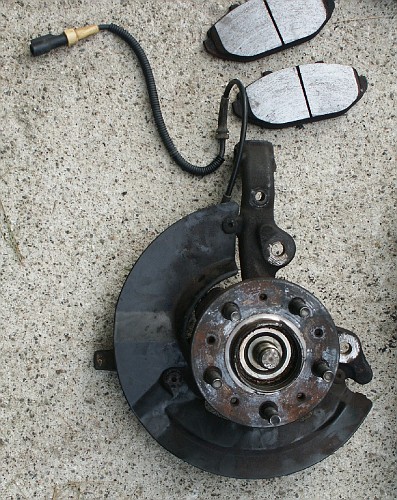
This wheel bearing isn't too rusty for a car this age in this area of
the country. But with 100k+ miles, it's somewhat worn and is going to
be replaced while the rotor is off anyways.
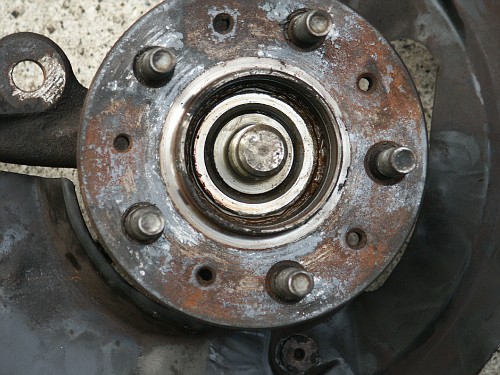
The wheel hub is held onto the spindle using a single nut hidden behind
a dust cap.


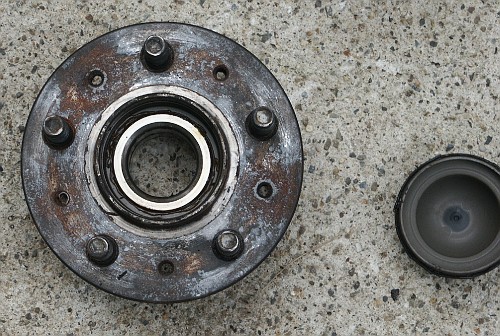
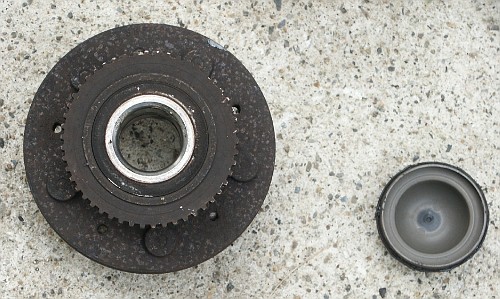
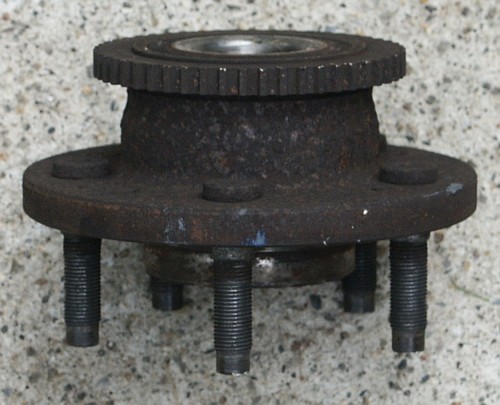
Here's the new wheel bearing hub assembly to install. No noticebale
rust present and the actual bearing of the hub assembly is much tighter
than the old one too.
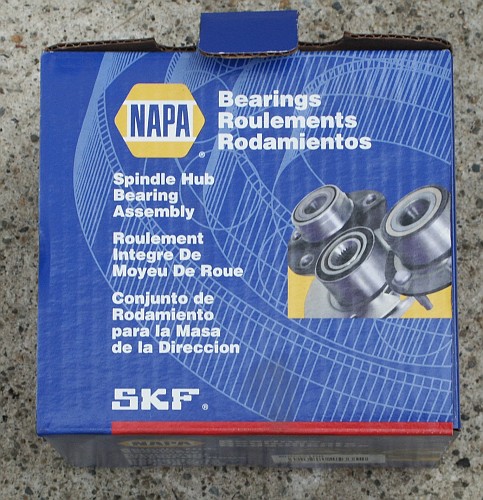
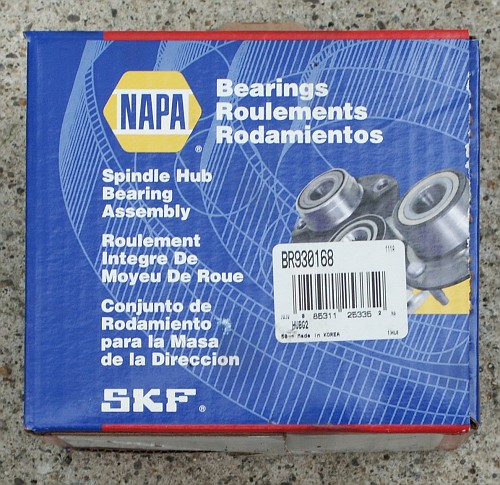
This box is generic for all of NAPA's SKF wheel bearings. Crownvics
don't have struts or cv joints.


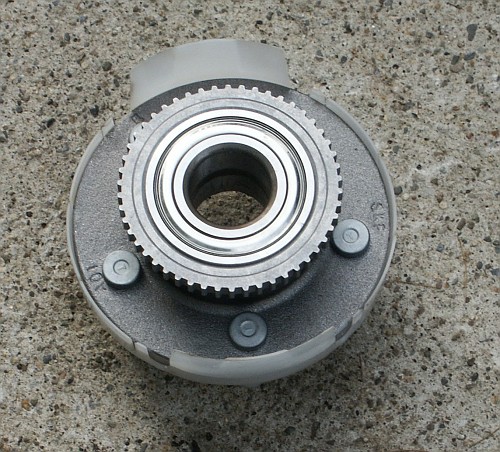

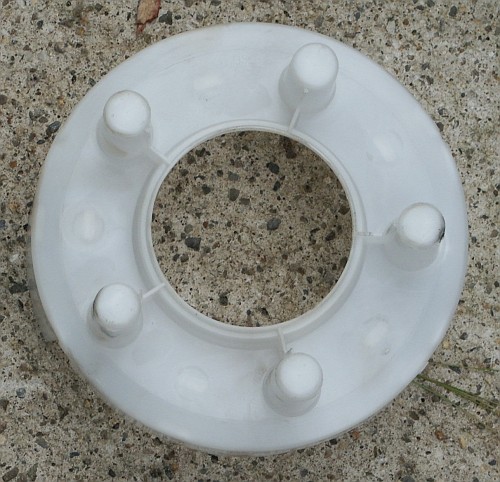
After the protective plastic cover has been removed
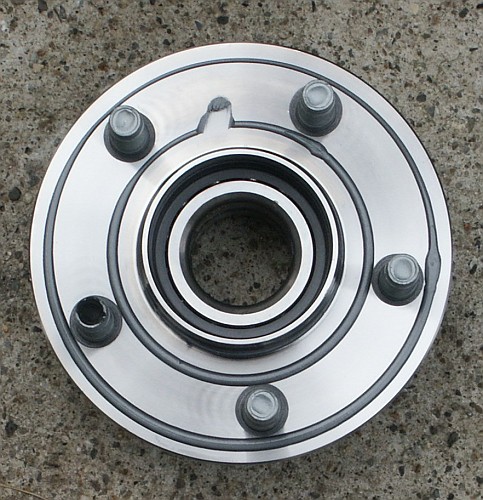
The layer of antiseize compound around the outer edges of the hub is to
keep moisture out so the metal doesn't corrode and cause excessive
runout.
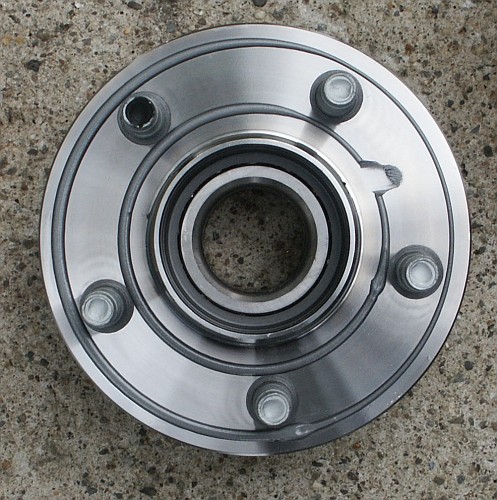
In the aftermarket, wheel hubs always seem to come with the antilock
brake sensor exciter ring installed regardless of whether you tell the
parts counter person that your car has antilock brakes or not. This
reduces the number of different part numbers that need to be stocked on
the store shelves.
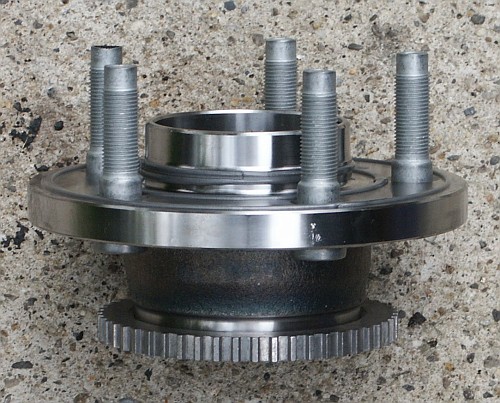
Here's a closeup of the antilock antilock brake wheel speed sensor
setup. Metallic brake dust debris can be cleaned off the sensor using
an aerosol can of brake parts cleaner.

This picture shows the later 1998+ solid stainless steel abs exciter
ring.
1992-1997 vehicles have a stamped steel abs tone ring that sometimes
corrodes badly on "rust belt" vehicles operated in areas of the country
where large quantities of chloride salts are used on the roads to clear
snow/ice during the winter. having some teeth go missing from an abs
tone ring due to heavy scaly rust will get the abs warning light
illuminated on your cars dashboard in a hurry.
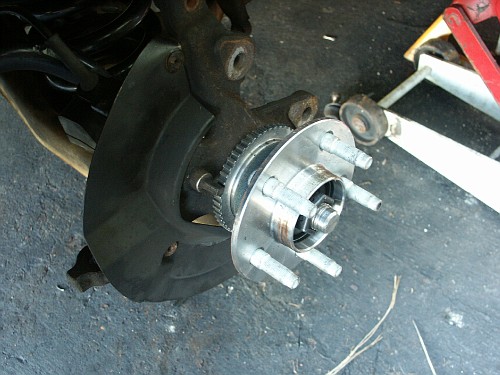
The 1995+ crown vics have removable front caliper brackets.
If for some reason you are replacing the front caliper with a new
service assembly during your brake job, make sure to remove the two
bolts which retain the caliper to the bracket prior to removing the
caliper bracket from the car. This will make sure that the caliper
bracket stays stationary while you are removing the bolts from the
slide pins.
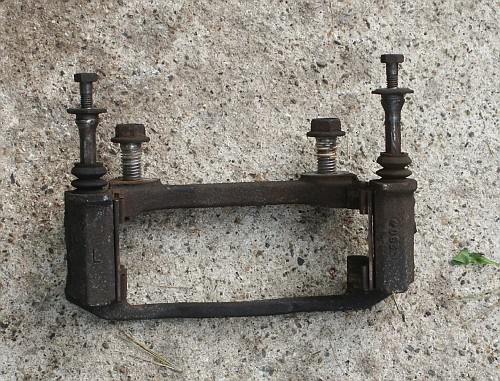
During a brake job, make sure to lubricate the slider pins with some
dielectric grease to prevent moisture intrustion and the associated
corrosion
Many professional fleet repair shops that work on a lot of crownvics
keep a spare set of these slider pins on hand. Failure points to watch
for include:
-damage to the threads
in the end of the slider pins where the caliper bolts would normally be
located
-evidence of corrosion from water intrustion. mechanically removing
corrosion with sandpaper or a wire brush is only a temporary mickey
mouse repair that will cause
problems in the future. the proper solution for a long lasting repair
is to replace the affected caliper slide parts with new service
assemblies.
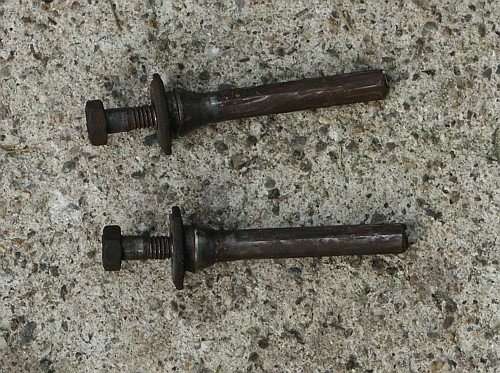
Some professional fleet repair shops also keep spare caliper brackets
on hand too.
The failure points to watch for here are:
-corrosion around where the boots seal to the bracket that could let
moisture in
-corrosion inside the bracket where the sliding pins would normally be
located
-excessive wear in the area where the pads slide on the bracket
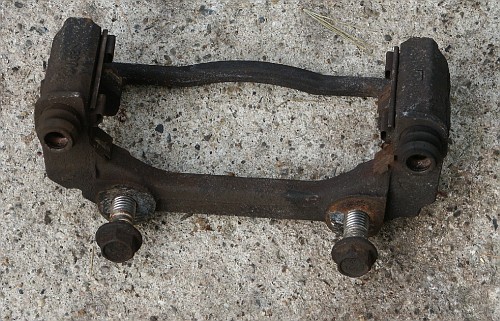
The bolts which retain the caliper bracket to the spindle are installed
really tight and have thread locker factory installed too. A 24-inch
breaker bar with a strong 18mm impact socket usually
gets them out without too much trouble though.

You don't normally have to remove the whole steering knuckle from the
car in order to do a brake job. But some other suspension work was
being done on the car during this project. And it's easy to get good
pictures of knuckle when it's out of the car.
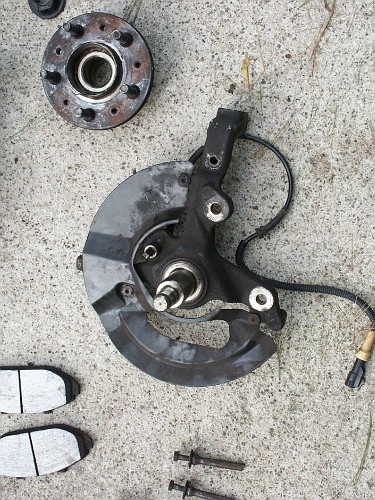
Here's the back of the steering knuckle. The two holes on the far left
are where the caliper bracket bolts would normally pass through.
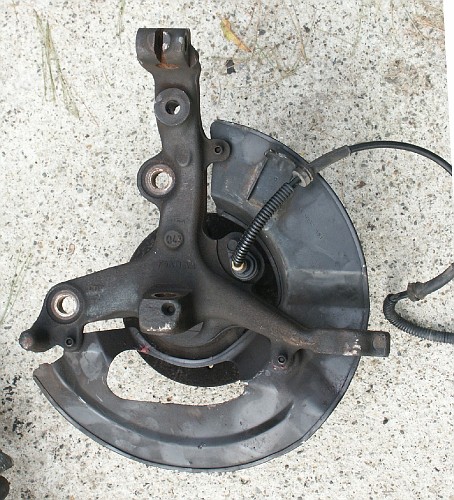

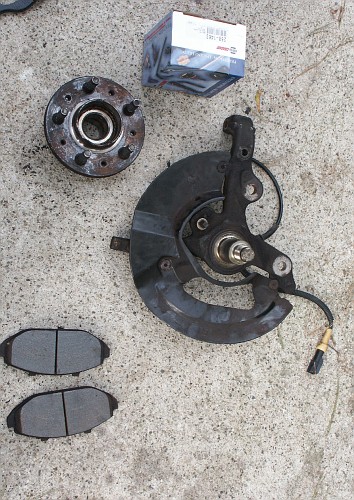
The nut which retains the wheel hub to the steering knuckle is a torque
to yield fastener that the ford shop manual states must be replaced
everytime it is removed. But many mechanics report sucessfully re-using
these nuts and not having the wheels fall off any of their customers'
cars yet.
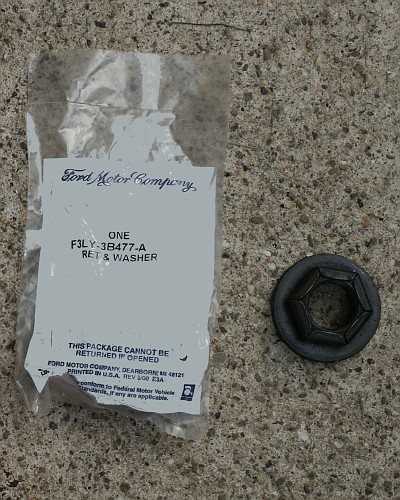

You will want a 36mm axle nut socket for this nut.
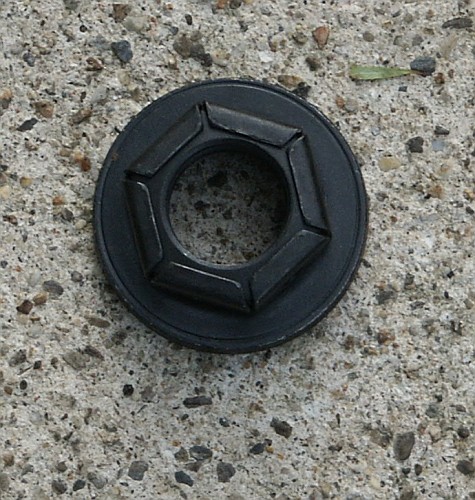
Here is a 1997 crown victoria
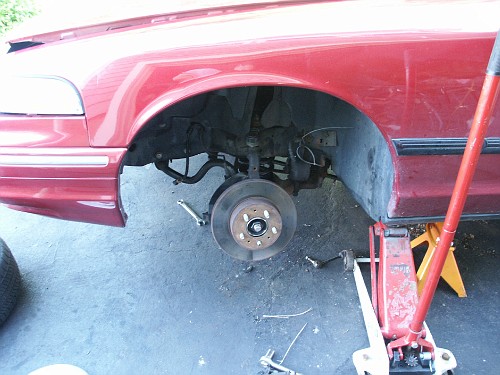
Here is the same 1997 crown victoria with a 1998-2002 brake rotor
installed on it. Notice the additional surface area?

Here is a 1997 rotor next to the later 1998+ "big brake" one
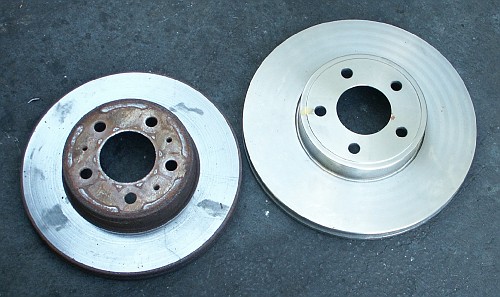
If you are interested in upgrading your 1979-1997 crown victoria to the
large brake setup pictured above, then click here for
additional information about this topic.
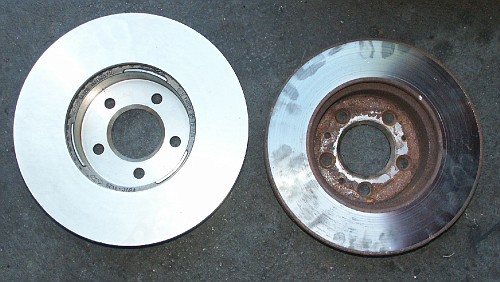

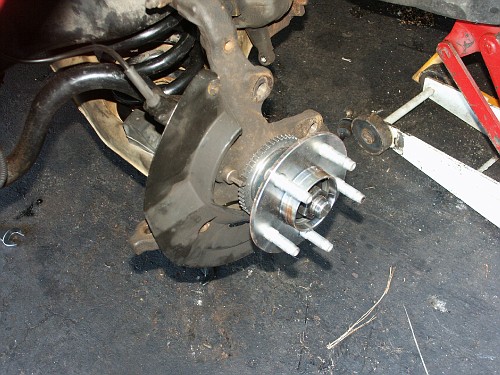
Here is the caliper bracket from a 1997 crown victoria. This unit is
physically smaller than the 1998 unit and doesn't have the removeable
brake pad slide surface slippers either.
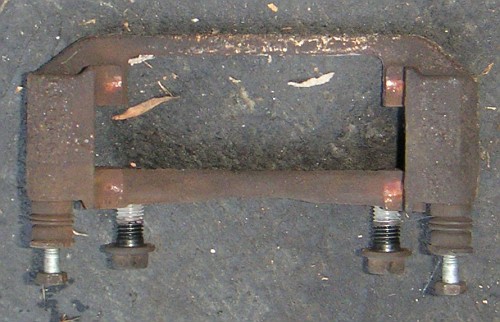

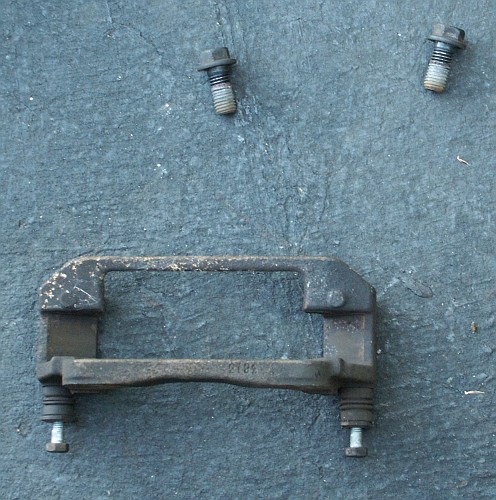
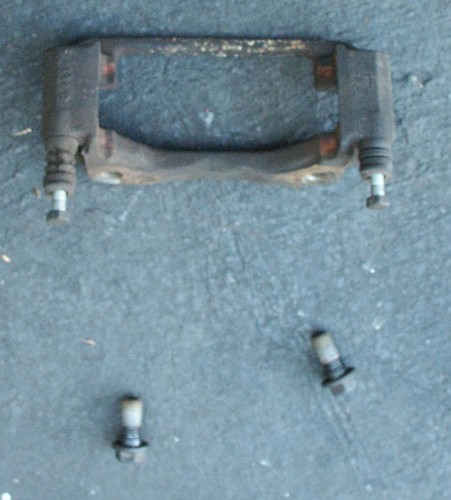
The bracket does use a similar sliding system to allow the front
calipers to float though.

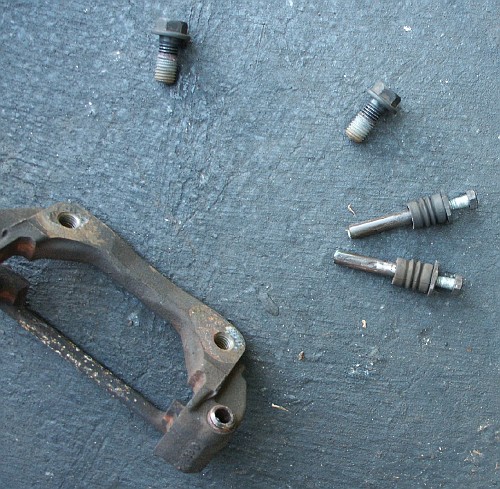
Here is a set of 98-02 "big brake" pads next to the 1997 ones.

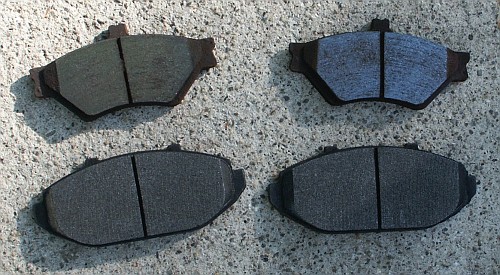

Below are some random front suspension pictures from a repair project
on a 1998 crown victoria. Eventually, these will be moved to a
different location. But for now, this webpage is in rough draft stage.
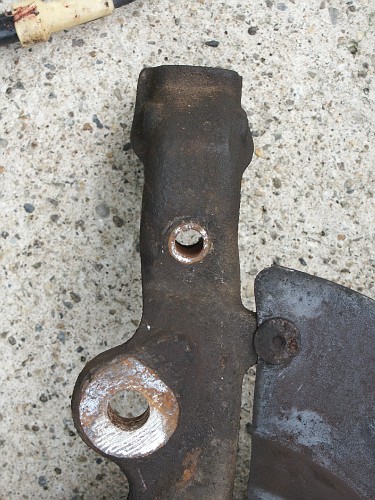

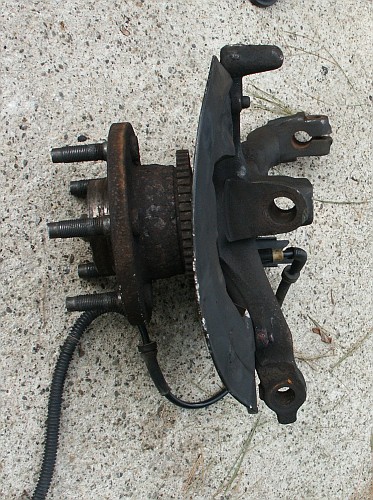

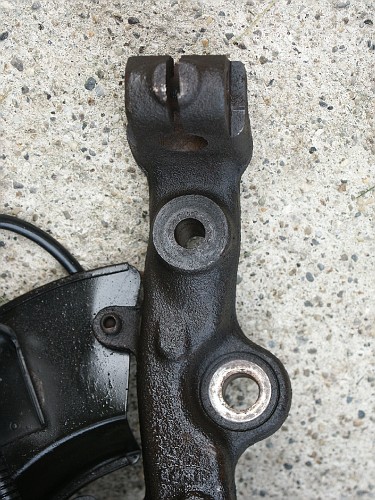




Notes:
-Liquid has a tutorial
online
about changing the brake pads and rotors in the 1998-2002 cars
online.
-For street driven cars, I recommend rubber flex hoses rather than the
braided stainless steel ones. With a track driven car, you probably
will never get debris wedged in between the stainless braid and the
teflon hose inside which could wear through and cause fluid leaks like
you might on a street driven car.
There is a wiki page
about this topic. Yes, this is a honda website. But SS brake flex hoses
for acura vehicles are constructed the same as the ones for ford
vehicles.
-If you can't get your rear brake rotors off the axle, do be aware that
there is a minature parking brake mechanism that may be holding you up.
There are a couple picture scrapbooks online that may assist you with
this part of the project. The first scrapbook is of a 1997 crownvic, the other
scrapbook is of a 2000
crownvic. All the 1996-2002 cars use essentially the same TRW supplied rear parking brake setup.















































































